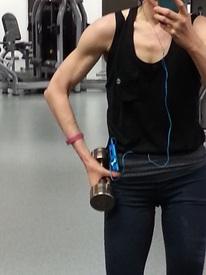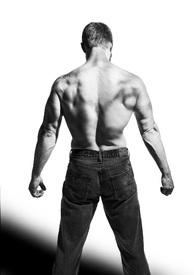Unusual Question
Options

Graelwyn75
Posts: 4,404 Member
I have COPD, meaning my lungs are impaired permanently, so basically, when I workout, I am exercising with lungs that are only 68% capacity, rather than the norm for my age group, which would be 84%. (Result of smoking and bad luck, diagnosed at 28).
I am curious as to how this would be impacting my nutritional needs, as in, would the fact I have to work harder when exercising, due to my lung issues, mean I am burning more energy?
I tend to push myself hard when I workout, even my cardio involves resistance, so obviously I end up breathing quite hard.
I remember when I posted a topic last year, regarding my cycling and my energy needs, someone seemed to think that my lung condition would cause me to use more energy when cycling up hills etc, due to the extra effort needed.
Anyone have any insight?
I am curious as to how this would be impacting my nutritional needs, as in, would the fact I have to work harder when exercising, due to my lung issues, mean I am burning more energy?
I tend to push myself hard when I workout, even my cardio involves resistance, so obviously I end up breathing quite hard.
I remember when I posted a topic last year, regarding my cycling and my energy needs, someone seemed to think that my lung condition would cause me to use more energy when cycling up hills etc, due to the extra effort needed.
Anyone have any insight?
0
Replies
-
Sorry, I missed this one. Unfortunately I do not have any insight as to this but hopefully someone will.0
-
My thoughts and opinion: Impaired lung capacity means that the volume of oxygen that you can take up maximally is reduced.
Therefore the amount of oxygen available at any time for aerobic metabolic function has a lower maximum.
Your maximum burn is reached earlier during cardio (HR is actually a little higher because of the reduced oxygen transfer at the lungs).
A higher HR only means higher oxygen consumption if oxygen is being transported. Reduced transport = reduced oxygen use, even at higher rate.
If you are using a HRM it will overestimate the actual calories burned (even though if feels terrible to you, you maxed out lower) anytime you are above 70-80% of your HR max.
Don't worry about it. You can still use the numbers to calculate your own TDEE using Sara's method - your estimate will be slightly incorrect if you used as an measuring stick against actual TDEE for another person but it will be fine for you if you work on keeping a constant exercise routine over several weeks. The numbers are always just an estimate. Get them and adjust based on observed weight loss and not the magical calculators except as starting points.
Btw, cardio workouts can help reverse some of the lung function loss (but not the lung damage) as well as diaphragm training. Stay fit=more efficient use of lung capacity.
Good luck.
Edit after some reading: there is evidence that BMR increases with COPD - possibly due to the increase effort just to breath normally. I didn't know this. (http://www.atsjournals.org/doi/full/10.1513/pats.200504-026SR) but during aerobic exercise that extra effort is offset by the changes in muscle and the reduced maximal function (not the most recent but good: http://dev.chestpubs.org/data/Journals/CHEST/21763/900.pdf)0 -
My thoughts and opinion: Impaired lung capacity means that the volume of oxygen that you can take up maximally is reduced.
Therefore the amount of oxygen available at any time for aerobic metabolic function has a lower maximum.
Your maximum burn is reached earlier during cardio (HR is actually a little higher because of the reduced oxygen transfer at the lungs).
A higher HR only means higher oxygen consumption if oxygen is being transported. Reduced transport = reduced oxygen use, even at higher rate.
If you are using a HRM it will overestimate the actual calories burned (even though if feels terrible to you, you maxed out lower) anytime you are above 70-80% of your HR max.
Don't worry about it. You can still use the numbers to calculate your own TDEE using Sara's method - your estimate will be slightly incorrect if you used as an measuring stick against actual TDEE for another person but it will be fine for you if you work on keeping a constant exercise routine over several weeks. The numbers are always just an estimate. Get them and adjust based on observed weight loss and not the magical calculators except as starting points.
Btw, cardio workouts can help reverse some of the lung function loss (but not the lung damage) as well as diaphragm training. Stay fit=more efficient use of lung capacity.
Good luck.
Edit after some reading: there is evidence that BMR increases with COPD - possibly due to the increase effort just to breath normally. I didn't know this. (http://www.atsjournals.org/doi/full/10.1513/pats.200504-026SR) but during aerobic exercise that extra effort is offset by the changes in muscle and the reduced maximal function (not the most recent but good: http://dev.chestpubs.org/data/Journals/CHEST/21763/900.pdf)
Hi, thanks for responding.
I know I sadly cannot reverse the effects, it is still somewhat of a piss me off thing that I am permanently stuck with damaged lungs now as obviously it does limit what I can do. I am unlikely, for example, to ever be able to get fully into running, even though I enjoy it, as outdoor running is very taxing on me. Cycling, thus far, seems to be what I am best at doing longer distances. I am not a more severe case, fortunately, so I can run for 30-40 minutes outdoors at a time without collapsing into a heap, haha. Also, my issue tends not to be with how much I can take in, the issue for me lays in the breathing out part. My maximum input of oxygen was actually above the norm last time I was checked, but the exhalation was an issue for me. I could not exhale the same as other people my age. Forgot the technical terms for this.
I seem to maintain weight on quite a high calorie intake when doing my workouts, which is one reason I asked, though that could be down to my bodyfat % I suppose. I no longer use my hrm to calculate burns, but know it used to get to up to 90% of my max when going up an especially steep hill on a windy day on my bike, and the elliptical always had it pretty high. It certainly does feel I have to work harder when I do certain exercise, for sure, which is another reason I wondered. But then I have been told by a trainer that I do push myself harder than most he sees at the gym.0 -
Welcome!
The expiration issue is pretty much the classic COPD tableau. Total exhalation volume is reduced which reduced the overall volume transfer (which was what I was working for my assumptions above).
Actually lung function is really really complex and while I studied part of it 20 years ago and worked on marketing a leukotrienne inhibitor more recently consider what I wrote above just an educated opinion.
As your overall oxygen function is reduced you possibly have another strong reason to weight train along side the cycling. One of the systemic effects of long term COPD is muscle weakness possibly from the reduced oxygen supply at rest leading to muscle wasting. Active use, by cycling and resistance training will not only provide functional endurance but limit that negative systemic effect of COPD. No references for this now but certainly something I read back 3-4 years ago.0 -
My thoughts and opinion: Impaired lung capacity means that the volume of oxygen that you can take up maximally is reduced.
Therefore the amount of oxygen available at any time for aerobic metabolic function has a lower maximum.
Your maximum burn is reached earlier during cardio (HR is actually a little higher because of the reduced oxygen transfer at the lungs).
A higher HR only means higher oxygen consumption if oxygen is being transported. Reduced transport = reduced oxygen use, even at higher rate.
If you are using a HRM it will overestimate the actual calories burned (even though if feels terrible to you, you maxed out lower) anytime you are above 70-80% of your HR max.
Don't worry about it. You can still use the numbers to calculate your own TDEE using Sara's method - your estimate will be slightly incorrect if you used as an measuring stick against actual TDEE for another person but it will be fine for you if you work on keeping a constant exercise routine over several weeks. The numbers are always just an estimate. Get them and adjust based on observed weight loss and not the magical calculators except as starting points.
Btw, cardio workouts can help reverse some of the lung function loss (but not the lung damage) as well as diaphragm training. Stay fit=more efficient use of lung capacity.
Good luck.
Edit after some reading: there is evidence that BMR increases with COPD - possibly due to the increase effort just to breath normally. I didn't know this. (http://www.atsjournals.org/doi/full/10.1513/pats.200504-026SR) but during aerobic exercise that extra effort is offset by the changes in muscle and the reduced maximal function (not the most recent but good: http://dev.chestpubs.org/data/Journals/CHEST/21763/900.pdf)
^ Thanks!0 -
Welcome!
The expiration issue is pretty much the classic COPD tableau. Total exhalation volume is reduced which reduced the overall volume transfer (which was what I was working for my assumptions above).
Actually lung function is really really complex and while I studied part of it 20 years ago and worked on marketing a leukotrienne inhibitor more recently consider what I wrote above just an educated opinion.
As your overall oxygen function is reduced you possibly have another strong reason to weight train along side the cycling. One of the systemic effects of long term COPD is muscle weakness possibly from the reduced oxygen supply at rest leading to muscle wasting. Active use, by cycling and resistance training will not only provide functional endurance but limit that negative systemic effect of COPD. No references for this now but certainly something I read back 3-4 years ago.
Thanks and yes, I do strength training 2-3 times a week and have been doing so since the end of last year. Until then, I had done only cycling mostly. I do a fair amount of different forms of cardio, and in spite of my condition, have been told by a few trainers at my gym that I am fitter than most they see working out there, which was reassuring to know. I am hoping that aside from the normal decline you get with age, my lungs will remain pretty much the same level since I stopped smoking as soon as I was diagnosed at 28.
I also heard swimming is very good for strengthening lungs, so I should take that up again.
I do not use any inhalers thus far, although I was offered them.
Whether that is a good or a bad thing, I don't know. Just not keen on relying on such things and figured if I can cycle for hours at a time, I am doing pretty okay.0 -
Locking so we can keep track of active threads. If you wish for the thread to be unlocked should you have further questions, please feel free to PM either myself or SideSteel, including a link to this thread and we will unlock it so you can pose them.0
This discussion has been closed.


